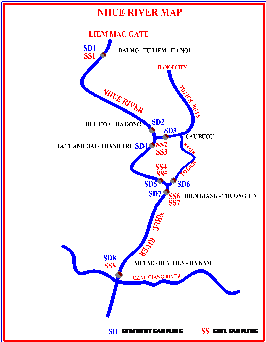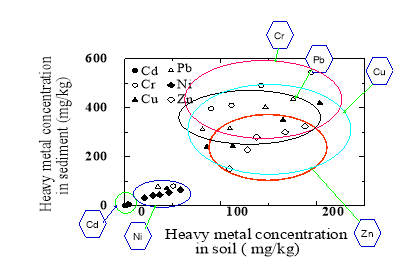The Nhue River stems from the Red River, flows through several western districts of Hanoi such as Cau Giay, Tu Liem and Thanh Tri, also it runs through Ha Dong Town, Hoai Duc, Thuong Tin, Thanh Oai, Phu Xuyen districts and finally joins the Day River near Phu Ly Town of Ha Nam Province. The Nhue River with the catchments area of 1070 km 2 and 40 km long, has source from the Red River about 11 km to the north west of Hanoi, and joins with the To Lich and Kim Nguu Rivers some 20 km downstream of Hanoi (Trinh et at., 2007). The mean inflow to the Nhue River from the Red River is 26m 3 /s and it typically receives around 5.8 m 3 /s of untreated wastewater from the To Lich and Kim Nguu Rivers (Trinh et at., 2007). The Nhue River water is used for agricultural and aqua cultural activities. The total basin of this river is more than 100,000 ha; 88,000 ha for Hanoi and 20,000 ha for Ha Nam (Trinh et at., 2007). The Nhue River is estimated highly polluted, especially in the Thanh Tri district where the To Lich and Kim Nguu Rivers carry wastewater from Hanoi into the Nhue River.
The objectives of this study are evaluating the heavy metal pollution of sediment of the Nhue River that receives waste water from the To Lich and Kim Nguu Rivers and assessing the effects of polluted irrigation water on the soil by examining the quality of agricultural in the Nhue River’ basin.
Materials and methods
1. Materials and field sampling
Sediment and soil samples were taken along the Nhue river on January 21–24 of 2009 (Fig.1). Totals of 40 surface sediment samples were colleted at 6 locations in the Nhue River SD 1, SD 2, SD 4, SD 5, SD7 and SD 8 (from upper stream to down stream of the river) and 2 locations in the To Lich and Kim Nguu rivers system SD 3 and SD 6 (just before connecting with the Nhue River). At each location, five sediment samples were taken.
Also, the totals of 80 surface soil samples were colleted at 8 locations SS 1-SS 8 (as the same location with taking sediment samples) along the Nhue River. At each location, 10 soil samples were taken.
The samples were air-dried, ground, passed through a 1-mm sieve, and preserved in plastic bottles at room temperature and for analyzing.

Fig. 1: Site sampling location
2. Total heavy metal concentration
For total heavy metal concentration, one g of air-dried sediment sample was digested with 5 ml of concentrated HNO 3. The mixture was brought to a slow boil by heating the flask at 96 0 C on a hot plate for an hour. After the mixture was boiled down to about 2ml, the additional 5ml of concentrated HNO 3 was added. A reflux cap was placed onto the flask, and the mixture was boiled for approximately 2h. The solution was transferred into 50ml volumetric flask and made up to the mark with distilled water after cooling. The solution was analyzed for Cd, Cr, Cu, Ni, Pb and Zn by atomic absorption spectrometry (SOLAAR m, Nippon Jarrel-ash Co., Ltd., Japan). The determination was made in duplicate and the relative deviation of the duplicate values was usually less than 5 % (Committee of Soil Standard Methods for Analyses and Measurements,1986).
RESULTS AND DISCUSSION
1. Heavy metal concentrations in the sediment
Table 1 also shows the average total heavy metal concentrations of 8 sediment samples at the same location along with the maximum permissible level for crop growth (MOSTE, 2002). The metal concentration varied to a great extent among the samples: 0.71–8.7 mg/kg for Cd, 80–583 mg/kg for Cr, 71–420 mg/kg for Cu, 32–69.8 mg/kg for Ni, 77.4–433.6 mg/kg for Pb and 150–350 mg/kg for Zn. In comparison with the maximum permissible level for crop growth, Cd, Cr Cu and Pb exhibited the highest pollution where the metal concentrations exceeded the permissible level in all sampling site while Zn and Ni were below the permissible level in all sampling sites.
Table 1
Total heavy metal concentration in the sediment
|
Location |
Cd |
Cr |
Cu |
Ni |
Pb |
Zn |
|
(mg kg -1 ) |
||||||
|
SD1 |
0.71 |
80.0 |
71.00 |
77.40 |
150.0 |
32.00 |
|
SD2 |
0.91 |
125.8 |
106.4 |
138.6 |
195.8 |
41.60 |
|
SD3 |
8.70 |
583.2 |
385.2 |
410.8 |
350.0 |
69.80 |
|
SD4 |
7.38 |
490.4 |
350.4 |
401.0 |
300.0 |
54.20 |
|
SD5 |
3.30 |
410.0 |
243.6 |
314.6 |
280.0 |
44.20 |
|
SD6 |
4.48 |
446.6 |
308.4 |
392.8 |
300.0 |
51.00 |
|
SD7 |
5.62 |
544.6 |
420.0 |
433.6 |
324.4 |
64.60 |
|
SD8 |
3.16 |
396.0 |
240.80 |
310.60 |
227.6 |
41.40 |
|
ML* |
2 |
50 |
0.71 |
80.0 |
71.00 |
|
*. ML: Maximum level for crop growing (MOSTE, 2002)
2. Heavy metal concentration in the soil
Total heavy metal concentrations in the soil samples are shown in Table 2. The concentration of the heavy metals was in range of 44–206.7 mg/kg for Cu, 34.6–182.6 mg/kg for Pb, 109.1–194.4 mg/kg for Zn, 0.14–4.65 mg/kg for Cd, 50.6–204.1 mg/kg for Cr, and 20.6–60.4 mg/kg for Ni. The metal concentration was higher in the soil samples that nearer pump station than others, because heavy metals in river water were diluted when flowing into the canal.
Table 2
Total heavy metal concentration in the soil samples
|
Location |
Distance from The pump station (m) |
Cd |
Cr |
Cu |
Ni |
Pb |
Zn |
|||||
|
(mg kg -1 ) |
||||||||||||
|
SS 1 |
0 |
0.14 |
50.60 |
44.00 |
34.60 |
109.1 |
20.60 |
|||||
|
SS 2 |
0 |
3.90 |
154.9 |
197.2 |
167.5 |
176.3 |
49.60 |
|||||
|
SS 3 |
500 |
3.36 |
130.10 |
133.0 |
126.3 |
158.2 |
42.40 |
|||||
|
SS 4 |
0 |
2.94 |
118.8 |
116.0 |
119.3 |
146.7 |
39.10 |
|||||
|
SS 5 |
200 |
2.60 |
104.0 |
109.3 |
100.0 |
128.8 |
33.80 |
|||||
|
SS 6 |
0 |
4.65 |
204.10 |
206.7 |
182.6 |
194.4 |
60.40 |
|||||
|
SS 7 |
200 |
4.24 |
185.4 |
200.4 |
169.0 |
181.8 |
56.00 |
|||||
|
SS 8 |
0 |
2.29 |
90.00 |
85.60 |
81.10 |
128.2 |
29.20 |
|||||
|
BGL* |
0.16 |
62 |
73 |
34 |
32 |
115 |
||||||
|
TCVN** |
2 |
50 |
70 |
200 |
||||||||
* Background levels of heavy metals in agricultural soils of Tu Liem District of Hanoi, Vietnam (Ho et al., 1998)
** Vietnamese standard (7209–2002: MOSTE of Vietnam, 2002) for heavy metal concentration in agricultural soils (MOSTE, 2002)
Compared with the background level of heavy metals in the soil that has not been subjected to polluted irrigation water (Ho et al. , 1998) heavy metals in all locations of the study site exhibited higher concentration, and the total concentrations of Cd, Cu and Pb exceeded the permissible level of the Vietnamese standard (TCVN 7029–2002) for agricultural soil (Cd: 2 mg kg -1 ; Cu: 50 mg kg -1 ; Pb: 70 mg kg -1 ). These indicate that the excess heavy metal concentrations in the soil are mainly due to the application of polluted irrigation water to the paddy field.
3. Correlation between heavy metal concentration in the soil and in the sediment
Figure 2 shows the positive correlation between heavy metal concentrations in the soil sand sediment samples. High heavy metal concentration in the sediment was a result highly accumulation of that in the sediment.

Fig. 2. Correlation between total heavy metal concentration in the soil and sediment
Conclusion
The heavy metal concentration of sediment samples varied to a great extent by the difference of the sampling sites and metal type. Sediments in the Nhue River are heavily polluted with Cd, Cr, Cu and Pb. In comparison with the maximum permissible level for crop growth, most of heavy metals exceeded the permissible level. The total heavy metal concentration in the sediment was correlated with clay fraction.
The concentrations of Cd, Cu and Pb in the soil exceeded the permissible level of Vietnamese standard for agricultural soil. There is very good correlation between the total heavy metal concentration in the sediment and in the soil in the same location.
References:
- Committee of Soil Standard Methods for Analyses and Measurements, 1986, Soil Standard Methods for Analyses and Measurements. Hakuyusha. Tokyo.
- Ho, T. L. T, Hoang, X. P. and Egashira, K., 1998, Chemical, physical and mineralogical properties of soils in Tu Liem and Thanh Tri districts of Hanoi city, Vietnam. Journal of Faculty Agricultural, Kyushu University, 43, 281–291.
- Ministry of Science Technology and Environment, Vietnam, 2002, The standard for the Quality of Water and Soil.
- Trinh, A. D., Vachaud, G., Bonnet, M.P., Prieur, N., Vu, D. L., and Le, L.A., 2007, Experimental investigation and modeling approach of the impact of urban waste on a tropical river: a case study of the Nhue River, Hanoi, Vietnam. Journal of Hydrology, 334:347–358.







